对于大卫科波菲尔中人物的形象分析
大卫科波菲尔的主要人物与情节分析
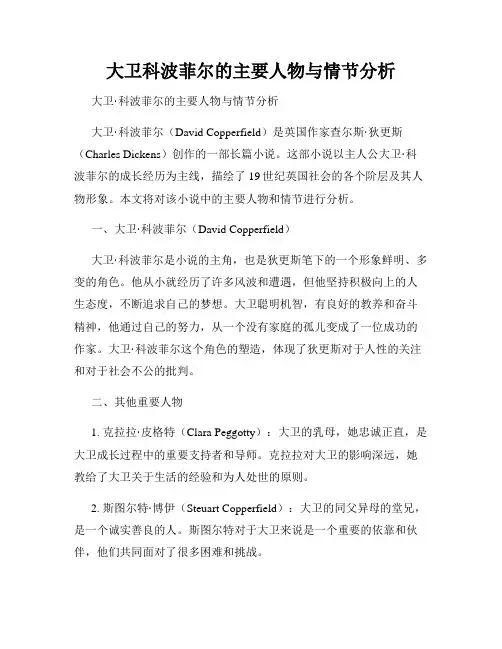
大卫科波菲尔的主要人物与情节分析大卫·科波菲尔的主要人物与情节分析大卫·科波菲尔(David Copperfield)是英国作家查尔斯·狄更斯(Charles Dickens)创作的一部长篇小说。
这部小说以主人公大卫·科波菲尔的成长经历为主线,描绘了19世纪英国社会的各个阶层及其人物形象。
本文将对该小说中的主要人物和情节进行分析。
一、大卫·科波菲尔(David Copperfield)大卫·科波菲尔是小说的主角,也是狄更斯笔下的一个形象鲜明、多变的角色。
他从小就经历了许多风波和遭遇,但他坚持积极向上的人生态度,不断追求自己的梦想。
大卫聪明机智,有良好的教养和奋斗精神,他通过自己的努力,从一个没有家庭的孤儿变成了一位成功的作家。
大卫·科波菲尔这个角色的塑造,体现了狄更斯对于人性的关注和对于社会不公的批判。
二、其他重要人物1. 克拉拉·皮格特(Clara Peggotty):大卫的乳母,她忠诚正直,是大卫成长过程中的重要支持者和导师。
克拉拉对大卫的影响深远,她教给了大卫关于生活的经验和为人处世的原则。
2. 斯图尔特·博伊(Steuart Copperfield):大卫的同父异母的堂兄,是一个诚实善良的人。
斯图尔特对于大卫来说是一个重要的依靠和伙伴,他们共同面对了很多困难和挑战。
3. 韦特尔欧道德(Uriah Heep):一个卑鄙阴险的角色,对大卫充满敌意。
韦特尔利用自己的权谋和阴谋不断陷害大卫,试图摧毁他的声誉和幸福。
韦特尔是狄更斯对于社会不公和权力滥用的形象化表达。
4. 阿加尼普·斯特朗(Agnes Wickfield):大卫的朋友和情人,她聪明善良,对大卫始终保持着支持和理解。
阿加尼普的形象展示了女性的独立和坚强,她和大卫一起经历了许多挫折和磨难,最终共同实现了自己的人生目标。
三、主要情节分析1. 童年和少年时期:大卫在母亲去世后,被送到了伦敦和墨西哥湾的袋匠工作室,与乳母克拉拉生活在一起。
大卫科波菲尔人物形象特点及事例
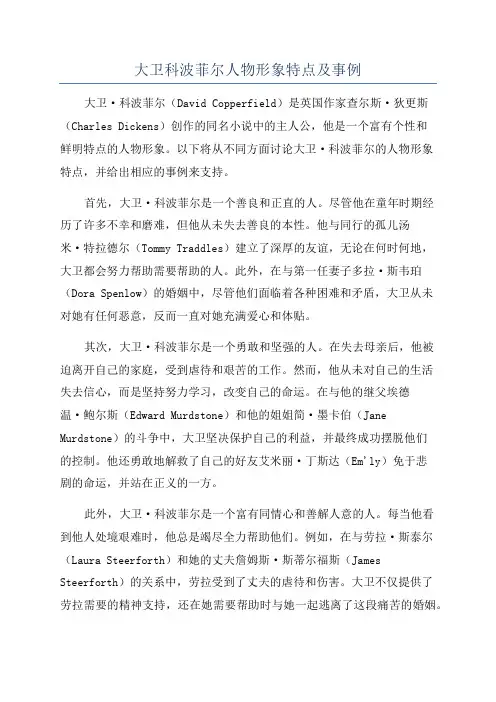
大卫科波菲尔人物形象特点及事例大卫·科波菲尔(David Copperfield)是英国作家查尔斯·狄更斯(Charles Dickens)创作的同名小说中的主人公,他是一个富有个性和鲜明特点的人物形象。
以下将从不同方面讨论大卫·科波菲尔的人物形象特点,并给出相应的事例来支持。
首先,大卫·科波菲尔是一个善良和正直的人。
尽管他在童年时期经历了许多不幸和磨难,但他从未失去善良的本性。
他与同行的孤儿汤米·特拉德尔(Tommy Traddles)建立了深厚的友谊,无论在何时何地,大卫都会努力帮助需要帮助的人。
此外,在与第一任妻子多拉·斯韦珀(Dora Spenlow)的婚姻中,尽管他们面临着各种困难和矛盾,大卫从未对她有任何恶意,反而一直对她充满爱心和体贴。
其次,大卫·科波菲尔是一个勇敢和坚强的人。
在失去母亲后,他被迫离开自己的家庭,受到虐待和艰苦的工作。
然而,他从未对自己的生活失去信心,而是坚持努力学习,改变自己的命运。
在与他的继父埃德温·鲍尔斯(Edward Murdstone)和他的姐姐简·墨卡伯(Jane Murdstone)的斗争中,大卫坚决保护自己的利益,并最终成功摆脱他们的控制。
他还勇敢地解救了自己的好友艾米丽·丁斯达(Em'ly)免于悲剧的命运,并站在正义的一方。
此外,大卫·科波菲尔是一个富有同情心和善解人意的人。
每当他看到他人处境艰难时,他总是竭尽全力帮助他们。
例如,在与劳拉·斯泰尔(Laura Steerforth)和她的丈夫詹姆斯·斯蒂尔福斯(James Steerforth)的关系中,劳拉受到了丈夫的虐待和伤害。
大卫不仅提供了劳拉需要的精神支持,还在她需要帮助时与她一起逃离了这段痛苦的婚姻。
他还对自己对他人的责任负起了责任,照顾他们的父母和奶奶,并关心他们的健康和福祉。
对于大卫科波菲尔中人物的形象分析
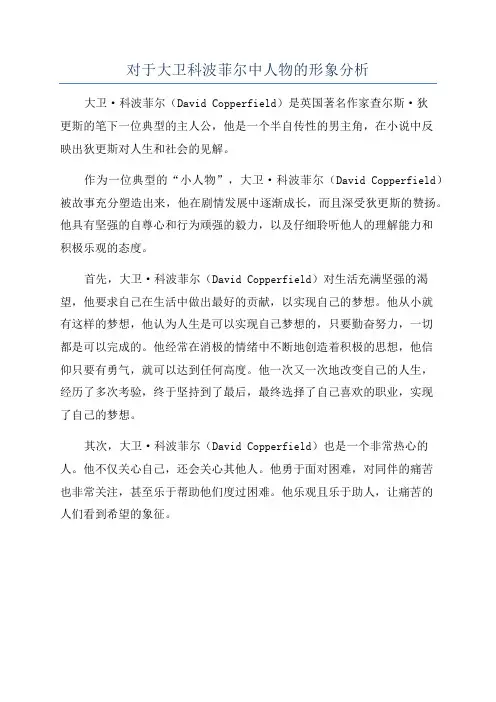
对于大卫科波菲尔中人物的形象分析
大卫·科波菲尔(David Copperfield)是英国著名作家查尔斯·狄
更斯的笔下一位典型的主人公,他是一个半自传性的男主角,在小说中反
映出狄更斯对人生和社会的见解。
作为一位典型的“小人物”,大卫·科波菲尔(David Copperfield)被故事充分塑造出来,他在剧情发展中逐渐成长,而且深受狄更斯的赞扬。
他具有坚强的自尊心和行为顽强的毅力,以及仔细聆听他人的理解能力和
积极乐观的态度。
首先,大卫·科波菲尔(David Copperfield)对生活充满坚强的渴望,他要求自己在生活中做出最好的贡献,以实现自己的梦想。
他从小就
有这样的梦想,他认为人生是可以实现自己梦想的,只要勤奋努力,一切
都是可以完成的。
他经常在消极的情绪中不断地创造着积极的思想,他信
仰只要有勇气,就可以达到任何高度。
他一次又一次地改变自己的人生,
经历了多次考验,终于坚持到了最后,最终选择了自己喜欢的职业,实现
了自己的梦想。
其次,大卫·科波菲尔(David Copperfield)也是一个非常热心的人。
他不仅关心自己,还会关心其他人。
他勇于面对困难,对同伴的痛苦
也非常关注,甚至乐于帮助他们度过困难。
他乐观且乐于助人,让痛苦的
人们看到希望的象征。
探索不同的人物角色特点
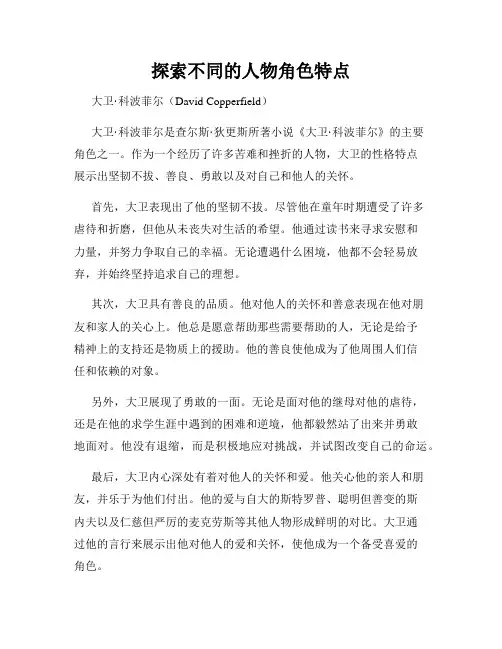
探索不同的人物角色特点大卫·科波菲尔(David Copperfield)大卫·科波菲尔是查尔斯·狄更斯所著小说《大卫·科波菲尔》的主要角色之一。
作为一个经历了许多苦难和挫折的人物,大卫的性格特点展示出坚韧不拔、善良、勇敢以及对自己和他人的关怀。
首先,大卫表现出了他的坚韧不拔。
尽管他在童年时期遭受了许多虐待和折磨,但他从未丧失对生活的希望。
他通过读书来寻求安慰和力量,并努力争取自己的幸福。
无论遭遇什么困境,他都不会轻易放弃,并始终坚持追求自己的理想。
其次,大卫具有善良的品质。
他对他人的关怀和善意表现在他对朋友和家人的关心上。
他总是愿意帮助那些需要帮助的人,无论是给予精神上的支持还是物质上的援助。
他的善良使他成为了他周围人们信任和依赖的对象。
另外,大卫展现了勇敢的一面。
无论是面对他的继母对他的虐待,还是在他的求学生涯中遇到的困难和逆境,他都毅然站了出来并勇敢地面对。
他没有退缩,而是积极地应对挑战,并试图改变自己的命运。
最后,大卫内心深处有着对他人的关怀和爱。
他关心他的亲人和朋友,并乐于为他们付出。
他的爱与自大的斯特罗普、聪明但善变的斯内夫以及仁慈但严厉的麦克劳斯等其他人物形成鲜明的对比。
大卫通过他的言行来展示出他对他人的爱和关怀,使他成为一个备受喜爱的角色。
总结来说,大卫·科波菲尔在《大卫·科波菲尔》中展现了坚韧、善良、勇敢和对他人关怀的特点。
他的经历和个性塑造了他成为一个鲜活而深刻的角色,使读者能够感受到他的成长和奋斗,从而在某种程度上与他产生共鸣。
通过对这些不同的角色特点的探索,我们可以更好地理解和欣赏小说中的人物形象,也可以从中获得一些人生的启示。
大卫科波菲尔中塑造人物形象的主要手法
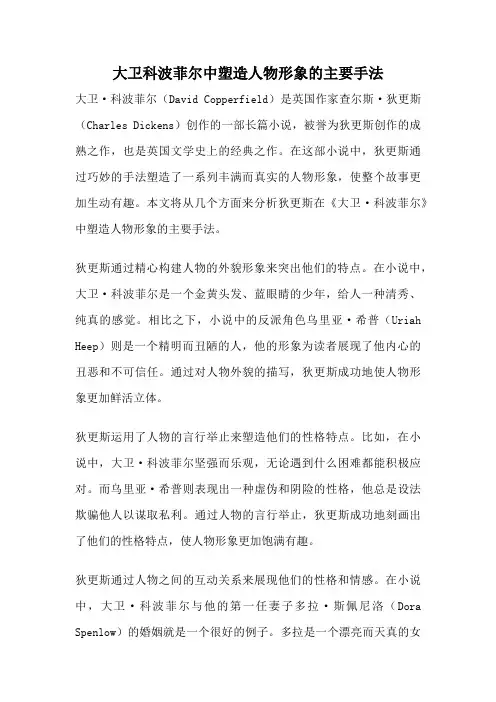
大卫科波菲尔中塑造人物形象的主要手法大卫·科波菲尔(David Copperfield)是英国作家查尔斯·狄更斯(Charles Dickens)创作的一部长篇小说,被誉为狄更斯创作的成熟之作,也是英国文学史上的经典之作。
在这部小说中,狄更斯通过巧妙的手法塑造了一系列丰满而真实的人物形象,使整个故事更加生动有趣。
本文将从几个方面来分析狄更斯在《大卫·科波菲尔》中塑造人物形象的主要手法。
狄更斯通过精心构建人物的外貌形象来突出他们的特点。
在小说中,大卫·科波菲尔是一个金黄头发、蓝眼睛的少年,给人一种清秀、纯真的感觉。
相比之下,小说中的反派角色乌里亚·希普(Uriah Heep)则是一个精明而丑陋的人,他的形象为读者展现了他内心的丑恶和不可信任。
通过对人物外貌的描写,狄更斯成功地使人物形象更加鲜活立体。
狄更斯运用了人物的言行举止来塑造他们的性格特点。
比如,在小说中,大卫·科波菲尔坚强而乐观,无论遇到什么困难都能积极应对。
而乌里亚·希普则表现出一种虚伪和阴险的性格,他总是设法欺骗他人以谋取私利。
通过人物的言行举止,狄更斯成功地刻画出了他们的性格特点,使人物形象更加饱满有趣。
狄更斯通过人物之间的互动关系来展现他们的性格和情感。
在小说中,大卫·科波菲尔与他的第一任妻子多拉·斯佩尼洛(Dora Spenlow)的婚姻就是一个很好的例子。
多拉是一个漂亮而天真的女孩,但她对婚姻和家庭缺乏责任感,这导致了他们的婚姻破裂。
通过大卫和多拉之间的互动,狄更斯成功地揭示了人物的性格特点和情感状态,使读者更加深入地了解他们。
狄更斯善于通过人物的心理描写来展示他们的内心世界。
在小说中,大卫·科波菲尔经历了一系列的挫折和磨难,但他始终保持着对美好生活的向往和对未来的希望。
通过对大卫内心的描写,狄更斯成功地展示了他坚强的意志和乐观的态度。
高中语文大卫科波菲尔人物形象
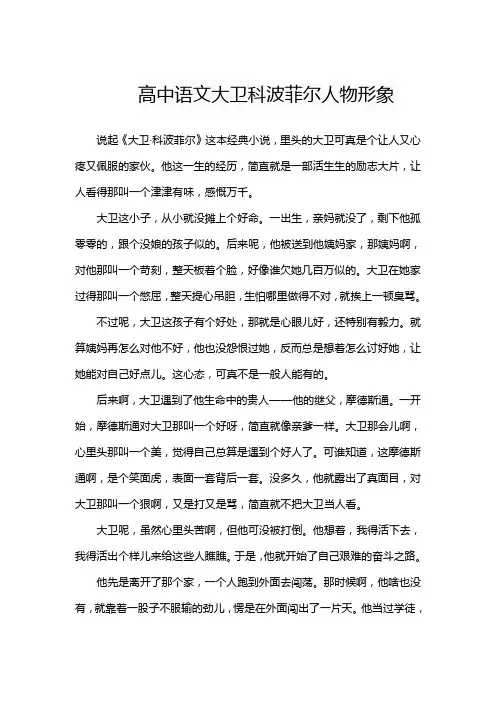
高中语文大卫科波菲尔人物形象说起《大卫·科波菲尔》这本经典小说,里头的大卫可真是个让人又心疼又佩服的家伙。
他这一生的经历,简直就是一部活生生的励志大片,让人看得那叫一个津津有味,感慨万千。
大卫这小子,从小就没摊上个好命。
一出生,亲妈就没了,剩下他孤零零的,跟个没娘的孩子似的。
后来呢,他被送到他姨妈家,那姨妈啊,对他那叫一个苛刻,整天板着个脸,好像谁欠她几百万似的。
大卫在她家过得那叫一个憋屈,整天提心吊胆,生怕哪里做得不对,就挨上一顿臭骂。
不过呢,大卫这孩子有个好处,那就是心眼儿好,还特别有毅力。
就算姨妈再怎么对他不好,他也没怨恨过她,反而总是想着怎么讨好她,让她能对自己好点儿。
这心态,可真不是一般人能有的。
后来啊,大卫遇到了他生命中的贵人——他的继父,摩德斯通。
一开始,摩德斯通对大卫那叫一个好呀,简直就像亲爹一样。
大卫那会儿啊,心里头那叫一个美,觉得自己总算是遇到个好人了。
可谁知道,这摩德斯通啊,是个笑面虎,表面一套背后一套。
没多久,他就露出了真面目,对大卫那叫一个狠啊,又是打又是骂,简直就不把大卫当人看。
大卫呢,虽然心里头苦啊,但他可没被打倒。
他想着,我得活下去,我得活出个样儿来给这些人瞧瞧。
于是,他就开始了自己艰难的奋斗之路。
他先是离开了那个家,一个人跑到外面去闯荡。
那时候啊,他啥也没有,就靠着一股子不服输的劲儿,愣是在外面闯出了一片天。
他当过学徒,干过苦力,啥活儿都干过。
虽然累得跟条狗似的,但他心里头那个乐啊,因为他知道,自己离梦想又近了一步。
后来啊,大卫遇到了好多好心人,他们给了他帮助,给了他温暖。
这让大卫更加坚定了自己的信念,那就是要做个好人,要回报社会。
他努力学习,提升自己,终于啊,他的努力得到了回报,他成为了一个有学问、有见识的人。
再回首看看大卫这一路走来,那叫一个不容易啊。
他经历了多少风风雨雨,才换来了今天的成就。
但你看他,脸上始终挂着笑,那是一种经历过沧桑后的淡然,也是一种对生活的热爱。
大卫科波菲尔人物形象特点及事例
大卫科波菲尔人物形象特点及事例大卫·科波菲尔(David Copperfield)是英国作家查尔斯·狄更斯于1850年创作的一部小说的主人公。
这是一部描写主人公从孩提时代到成年的成长故事,也是狄更斯最负盛名的作品之一、大卫科波菲尔这个形象富有鲜明的特点,具有强烈的个性和内心的复杂性,通过他的经历和成长过程,狄更斯发表了对社会现象的批判,探讨了个人的自由和权利。
大卫科波菲尔的第一大特点是他的善良与仁慈。
从小被母亲抛弃,大卫一直生活在自由的环境中。
他在亚特金斯舅舅家生活期间,对待鲜卑舅妈和她的两个女儿非常友善,关怀备至。
他经常会帮助家里的售货员乔尔·波丁,甚至为了救助乔尔而与鲜卑起了冲突。
大卫的善良和仁慈在他的朋友圈中也得到了充分展示,如他与汤米·汤纳和斯特朗格课堂上建立的友谊,以及对他人的慷慨和帮助。
第二个特点是大卫科波菲尔的坚韧和勇气。
大卫在少年时期经历了一系列的挫折和磨难,但他始终保持了对未来的乐观和积极向上的态度。
当他被送到福伍德家,受到了邪恶的尤利亚·刷金顿的虐待和歧视时,大卫坚持自己的原则,决不屈服。
他在前进学院受到了严厉的体罚,但他依然毫不气馁,坚定地与不公正进行斗争。
通过这些挫折和考验,大卫变得更加坚强、勇敢,克服了困难,为自己的欲望和自由而战。
另一个特点是大卫科波菲尔的聪明和智慧。
尽管他没有正式的教育,但大卫天生聪明才智。
他对学习有浓厚的兴趣,利用闲暇时间进行各种各样的自学。
大卫很早就展示了他写作天赋,通过写作来表达他的思想和感受。
他通过自学和实践,成为了一名优秀的律师,并且在工作中取得了极大的成功。
他的智慧和才能使他能够应对各种困难和挑战,为他打开了更多的机会。
最后一个特点是大卫科波菲尔的善解人意和宽容。
尽管大卫年轻时遭受了伤害和背叛,但他能够理解他人的处境,并对罪人心存怜悯和宽容。
面对自己的童年挚友汤米的背叛,大卫并没有埋怨,反而感到同情和理解,因为他明白汤米的沮丧和失望导致了他的行为。
大卫科波菲尔主要人物形象
人物形象赏析(1)主人公大卫·科波菲尔:大卫·科波菲尔是《大卫·科波菲尔》中的主人公,曾经是个孤儿。
作家描写了他从孤儿成长为一个具有人道主义精神的资产阶级民主主义作家的过程。
他善良,诚挚,聪明,勤奋好学,有自强不息的勇气、百折不回的毅力和积极进取的精神,在逆境中满怀信心,在顺境中加倍努力,终于获得了事业上的成功和家庭的幸福。
在这个人物身上寄托着狄更斯的道德理想。
(2)《大卫·科波菲尔》中的女性形象:在狄更斯笔下,《大卫·科波菲尔》塑造了一个个有血有肉的人物形象,每个任务都给人留下了深刻的印象,尤其是成功塑造了不同性格、不同品德的女性形象:贝西姨婆、艾妮斯、佩葛蒂、克拉拉、朵拉、摩德斯通小姐、密考伯太太、艾米丽……贝西姨婆与摩德斯通小姐的对比,克拉拉、朵拉与艾妮斯的对比更使她们栩栩如生,对贝西姨婆、艾妮斯、佩葛蒂的爱就更深一层,对摩德斯通小姐更是恨之入骨,对朵拉、克拉拉既同情又气愤。
大卫童年的灾星、继父的姐姐摩德斯通小姐的性格特点是极端冷酷和残忍。
从一出场就奠定了她这种性格:面色阴郁,皮肤黝黑,声音男性化,两道浓眉连在一起,她的钢制钱包合上的时候,咔哒一声,像是狠狠地咬谁一口,在狄更斯笔下,没有生命的东西也成了活的,她打扮时用钢制手铐和铆钉,这都是这位冷血的钢铁女人的性格写照。
摩德斯通小姐是一个十足的男人婆,她讨厌男人,却长着男人的脸孔,没有女性的温柔,没有爱心和同情心,她和她弟弟一直折磨可怜的克拉拉,并把大卫看成眼中钉,用各种手段折磨大卫,造成大卫童年的苦难。
以后,在朵拉的家中又出现了她阴郁的影子。
贝西姨婆在某些方面与摩德斯通小姐有相似之处,但她们有本质的不同:贝西姨婆脾气古怪,她对驴子非常敏感,驴子从门前草地经过是她一生最为气愤的。
她特立独行,敢说敢干,不顾世俗的眼光,略带男性气质,偏重理性,但是贝西姨婆博爱、善良、仁慈、心软、重感情,虽然她讨厌男孩,但是大卫投奔她后,她又收留了大卫,并把摩德斯通姐弟骂得痛快淋漓。
对于大卫科波菲尔中人物形象分析
对于大卫科波菲尔中人物形象分析
首先,大卫·科波菲尔是一个具有坚定决心的人。
在小说中,他被船
长艾哈布招募成为一名船员,参加了追逐白鲸莫比·迪克的航行。
尽管他
不是一个有经验的船员,但他英勇无畏地投身于这次冒险之中,并且决心
追寻和征服这条白鲸。
他身上展现出了面对困难时不畏惧、勇往直前的精神,这使得他在船员中倍受尊敬和赞赏。
其次,大卫·科波菲尔是一个坚守原则的人。
在小说中,当他看到船
长艾哈布变得疯狂并迷失在追逐白鲸的狂热中时,他始终保持自己的理智
和判断力。
与艾哈布不同,大卫·科波菲尔明白人与自然的关系,并且尊
重大自然的力量。
他不仅不愿去破坏自然界的平衡,还试图理解和遵循自
然的法则。
他的坚守原则使他成为一个忠诚的船员,而不是服从疯狂指挥
的奴仆。
此外,大卫·科波菲尔是一个追求自由的人。
在小说中,他对于航海
和冒险的热爱使他能够在海洋上找到自己的自由。
“海洋是我真正的家园,船只是我的避风港。
”他曾说。
他逍遥自在地在海上航行,没有束缚和拘束。
他渴望探索和发现新的事物,并且不断挑战自己的极限。
他的自由意
志成为他生活的动力,也使他超越了人们对他所属社会身份和角色的认知
和限制。
《大卫.科波菲尔》中的女性形象解读word资料5页
《大卫.科波菲尔》中的女性形象解读在《大卫?科波菲尔》中出现了众多的女性人物,这些女性无一例外都对主人公大卫产生了或积极或消极的影响。
在这些女性的身上,狄更斯传达了自己对于女性的最高理想,即在不违反社会传统观念的基础上同情和尊重女性,并按照自己的人道主义思想对那些背离了社会认为作为女性绝对不能违反的规则的女性人物进行批判。
一、病态人格型――摩得斯通小姐在大多数人看来,病态人格型的人都是一群被送上金钱祭坛的、灵魂扭曲变异的牺牲品,大多具有反抗或复仇意识,性格泼辣强悍、高傲冷漠。
先看一下摩得斯通小姐的出场时作者对她的描写,这一段描写在很大程度上揭示了摩得斯通小姐的性格:“她是一个面色阴沉沉的女士。
她不仅像她弟弟一样黑黑的,面目和声音也像他。
她的眉毛生得很浓,几乎一直长到她那个大鼻子上了,仿佛她生错了性别而以此来代替胡须。
她随身带来两只样子突兀、结结实实的黑箱子,箱盖上用铜钉结结实实地钉上了她的姓名缩写。
给车夫付钱时,她从一个结结实实的钱包中拿出钱来,然后把钱包放进一个包里囚禁起来再把这包一下用力关上,这包是用一根很粗的链条拴在她胳膊上的。
在那之前,我还从来没有见过一个像摩得斯通小姐那样的地道道的铁女人。
”从以后故事的发展我们可以看出,摩得斯通小姐不仅面色阴沉,性格也是极其阴沉的,这种阴沉冷酷除了遗传,更多的是受家族的环境而成,摩得斯通家族的阴沉专横、傲慢邪恶的环境氛围塑造出了摩得斯通先生,同样也塑造出了摩得斯通小姐。
尽管摩得斯通小姐名义上是姐姐,但实际上,她只是摩得斯通先生的附庸品,她必须服从自己的弟弟,对他俯首帖耳。
一直以来她都被压制着,可她从来都只是顺从,任由弟弟对自己呼来喝去,让弟弟的阴郁笼罩着自己的一生,同时却又帮助弟弟用自己家族的阴郁去控制克拉拉,压抑着这个实际上还是个孩子的母亲,管理着原本应该是姓科波菲尔的家,改变了大卫的一生,也使得大卫的母亲克拉拉抑郁而终。
她还帮着弟弟把大卫送到一个做酒买卖的货行当童工,并对他不闻不问,使大卫在年幼之时便尝尽了人生的酸甜苦辣。
- 1、下载文档前请自行甄别文档内容的完整性,平台不提供额外的编辑、内容补充、找答案等附加服务。
- 2、"仅部分预览"的文档,不可在线预览部分如存在完整性等问题,可反馈申请退款(可完整预览的文档不适用该条件!)。
- 3、如文档侵犯您的权益,请联系客服反馈,我们会尽快为您处理(人工客服工作时间:9:00-18:30)。
An Analysis of Image in David CopperfieldChapter1Introduction"David Copperfield", the masterpiece of Dickens, was a semi-autobiographical work. In May 1849 to November 1850, the installment was published. In the preface, Dickens said: “It is my favorite child.”The novel depicted David's experiences which were filled with sufferings and laughters. Dickens portrayed the colorful picture of British society, the typical image of different social classes, especially the endless struggle of David in the face of adversity which left a deep impression on us. David was unable to endure the abuse of his stepfather, biting the fingers of his stepfather, savagely beaten. As a result, he was locked in a boarding school. After his mother died, he was sent to the factory as a child by his stepfather. From then on, he lived a hard life, without enough to eat or wear and suffered all kinds of abuse and torture. However, David did not succumb to the mercy of fate, painstakingly, and finally found his aunt Betsey. The kind-hearted aunt shelter adopted him and let him go to a better school. When he knew that Aunt Betsey was bankrupted, but instead, he studied diligently with perseverance all kinds of abuse and torture. Finally, after making efforts, he became a writer and achieved success. At the same time, other characters were clear and vivid. Peggotty was a nurse who took care of David and David’s mother carefully, she was remarkably loyal. Outwardly, aunt Betsey appeared a severe woman, but she showed that she was kind by loving David and others. In addition, Ham was noble, brave and honest. Mr.Murdstones was fierce and cruel. Steerforth was selfish and arrogant.1.1 Introduction to the AuthorDickens was the main representative of realism literature in the 19th century. The art of witty words, nuanced psychological analysis and realism were combined together closely in his works. He was particularly famous for his vivid comic characterizations and social criticism. He was the first author who had written of the poor with fidelity and sympathy. His works were famous during novels of the Victorian age and among the great classics in all fiction.Dickens was born in February, 1812, at Landport, Portsmouth. He was the second of eight children. His father was a clerk, hardworking but imprudent, later caricatured as Mr. Micawber in David Copperfield.In 1822, the family moved to London, where Charles had to leave school to support his impoverished family. In 1824, his father was put into prison for debt. At the age of 12, Dickens was sent to going to work at a factory. He wrapped and labeled for 6 shillings a week. After work, he wandered through the streets of London, enthralled by the sight of the dockyards, the files of convicts, and vast sections of the city inhabited by the poor. These bitter days remained in his memory and later found expression in his works.Dickens was able to return to school because a small legacy helped release his father from prison. He was an avid reader and spent much time in the reading room of the British Museum. Although he later returned to school for a time, these experiences left a permanent imprint on the soul of Charles Dickens. Even many years later, he had become a successful author, he could not bear to talk about it, or be reminded of his family’s ignominy.At the age of fifteen, Dickens began working as an office boy for a law firm. He taught himself and he became a reporter for courts of Doctors’ Common in 1828. The dull routine of the legal profession never interested him, so he became a newspaper reporter for the Mirror of parliament, the True Sun, and finally for the Morning Chronicle.(John Forster, were later his closest friend and biographer, was also employed at the True Sun.)By the age of twenty, Dickens was one of the best parliamentary reporters all the England.By this time, Dickens was enjoying the luxurious life he had dreamed of as a child. In 1850, he published the last installments of David Copperfield, a partly autobiographical novel that was his favorite.1.2 The Introduction to the Background1.2.1 Social background“Like so many parents I hav e a favorite child in my heart,”wrote Charles Dickens. "And his name is David Copperfield." Here, Dickens made good use of his own life experience to expose the social evils that were prevalent in Victorian England and were the miseries of child-labor, the tyranny in schools, the debtors’ prison, as well as the cruelty and immortality and the treachery. Thus the novel was not merely a person al record, but a broad picture of the society of the author’s day.David Copperfield was a novel written in first-person point of view. It was sometimes referred to as an apprenticeship novel because it centered on the period in which a young person grew up. The type of novels was pioneered by Johann Wolfgang von Goethe (1749-1832) in his novel Wilhelm Meisters Lehrjahre (Wilhelm Meister's Apprenticeship). Dickens based the book in part on the difficult early years of his own life. The narration changed n ames, locales, and other details of Dickens’s life. For example, when Dickens was only a child, he had to leave school to work in a factory. In the novel, David Copperfield had to leave school to work in a warehouse washing and labeling bottles used in the wine trade. David’s initials (D.C.) were, of course, the reverse of Dickens’s (C.D.).Dickens was a master at drawing memorable characters. Some were simple and uncomplicated, like Barkis, Creakle, Murdstone, and Clara Peggotty. Others were complex, like David Copperfield. Throughout the novel, he befriended the wealthy and charming James Steerforth, ignoring his devious and malevolent side. At the same time, he befriended the good-hearted Tommy Traddles and the humble Peggottys. These two worlds, the world of Steerforth and the world of Steerforth and his family, both attracted David, and his immaturity decided what should constitute his own world. To bring his characters to life, Dickens invested them with clearly defining virtues or vices and described the characters in a way that enabled the readers to picture them at the scenes in which they appeared.1.2.2 Novel’s backgroundOf all the Dickens’ novels, David Copperfield reflected the events of Dickens own life the most. As for David, suffering in the past was adequately made up for a rich, happy marriage and a successful literary career, just like Dickens himself, and the world was still full of hope and sunshine. The plot construction was rather loose, but it also excelled in its vivid image. The narration of novel in detail was also worth mentioning, which gave the work truthfulness to the real life.What we could add to was the way in which Dickens time and time again dealt with the progress of a male hero who, as with David in David Copperfield (1849-50) and Pip in Great Expectations (1860-1), came to terms with world as the middle-class values. At the same time, however, Dickens’ heroes often have uncomfortable doubles: David Copperfield was shadowed by Heep and Steerforth, both of whom revealed the kind of dark sexual urge that David attempted to conceal or deny in his own life. It was as if, in a new middle-class code, Dickens was equally aware of theprecariousness or vulnerability of the new respectable social conception of the self, of the buried life that was hidden beneath the veneer of polite manners.Due to the early success, the public not only gave Dickens an assurance that made sure increasing powers of poetic expression and narrative technique, but also the confidence to demonstrate his priorities to a point where they contradicted the social assumptions of many of his readers. All his later novels, except A Tale of Two Citie s, presented a criticism of the most fundamental institutions of the Victorian England.Although David was ignorant of Steerforth’s treachery, we were aware from the moment we met Steerforth that he didn’t deserve of praise which David felt toward him. David didn’t know why he hated Heep or why he trusted a boy with a donkey cart who stole his money and left him in the road, but it was possible for him to realize Heep’s inherent evil and the boy’s real intention. In David’s first-person narration, Dickens conveyed the wisdom of the older man implicitly, through the eyes of a child.Chapter 2Literature Review of the Novel2.1 Some Scholars’ Views on the NovelScholars believed that David Copperfield's careers, friendships, love and life, were most highly influenced by Dickens' experiences, as well as his time working as a child. David's involvement with the law profession and later his career as a writer mirror the experiences of Dickens. Many of David's friends were based on people who Dickens actually knew, and David's wives, Agnes Wickfield and Dora, were believed to be based upon Dickens' attachment to Mary Hogarth. Dickens keenly felt his lack of education during his time at that factory, and according to the Forster biography, it was from these times that he drew David's working period.British writer Somerset Maugham regarded the book as "truly a masterpiece of literary works".One of American literature connoisseurs recommended the novel as one hundreds of the 20th century, distinguishing English novel.The famous Russian writer, Leo Tolstoy, said that the book was the best one among all the English novels and it could help people to build a perfect personality.“David Copperfield was filled with characters of the most astonishing variety, vividness, and originality,” noted Somerset Maugham. “They are not realistic and yet they abound with life. There never were such people as the Micawbers, Peggotty and Barkis, Traddles, Betsey Trotwood and Mr. Dick, Uriah Heep and his mother.” The story was told almost entirely from the point view of the first person narrator, David Copperfield himself, and was the first Dickens novel to do so. Dickens based the book in part on the difficult early years of his own life.2.2 Main Views of Dickens’ IdeaInfluenced by Carlyle, Dickens learned to direct his novel to a questioning of social priorities and inequalities, to a distrust of institutions, particularly defunct or malfunctioning ones, and to a pressure for action and earnestness He was prone to take up issues, and to campaign against what he saw as injustice or desuetude, using fiction in his novel. He was not alone in his own time, but his name continued to bepopularly associated with good causes and with remedies because he was quite the wittiest and he has had the most persuasive, and the most influential voice.Dickens was faithful to the teaching, and to the general framework, his thought, his action and above all, for his writing, nevertheless. A critical awareness that there was something deeply wrong with the society in which he lived disclosed the nature of a novel and gave its distinct political edge. Dickens’ novels were multifarious, digressive and humorous.In an important way, they reflected the nature of Victorian urban society with all its conflicts and disharmonies, its eccentricities and its constrictions, its energy and its fertility, both physical and intellectual. But the standard pattern in his novels was the basic conflict between money on the one hand, and loves on the other hand. What this conflict usually revealed was that the people who have greatest love for their fellow humans were also the ones who were most hurt by the world of money, simply because money was power.In his novels, the people who possessed most money and most power seemed incapable of love, whereas the people who were capable of love were remarkably often both poor and powerless. And yet, this gloomy view was emerged by Dickens’ comic way of dealing with his characters.Chapter 3The Image of main character in David Copperfield3.1 The Image of David3.1.1 Unyielding and diligence of David CopperfieldDavid Copperfield was a kind-hearted, honest, and hard working, pragmatic and progressive intellectual typically. Since Dav id’s childhood, his father died. Although his mother remarried, she died before long with his stepfather abuse. At that time, he was sent to boarding school, ravaged, and then was sent to the factory as an apprentice humiliation position. He left the factory to the home of aunt Betsey who adopted him and let him study law. Then, he tried his best to learn day after day. At the same time, his character matured in suffering, frustration, and ultimately on the right path in life. Later he became a writer, and married with his girlfriend. For him, he had acquired much knowledge in life through the wrong ideas, funny habits, sad moment and the depressing day, and remembered his aunt's words in heart, “whatever you do and whenever you do it, you can never be humble, never be hypocritical or cruel.”He thought of this sentence, which always encouraged himself to be strong and seize the hard-on opportunity to struggle in life.Both the hardships and bitterness in his orphan’s times or always struggle in his adult time, having experienced calamities and misfortunes, David tasted the joy and warmth of the earth. By his own sincerity, forthright personality, positive spirit, as well as the purity of love to people in his heart, he persisted and finally succeeded. 3.1.2 Innocence and kindness of David Copperfield.David began to love Emily when they accompanied each other in the days in Yarmouth. As for a child, the affection was a more feelings. Neither of them worried about the future or any other troubles at that time. The best was love in that they were innocent. On the way to Salen House, the writer mentioned an interested incident. With the “simple confidence and natural reliance of a child upon superior years”, David was used by Servant William. David was bound to lack of some worldly wisdom and was only an innocent child.When David worked at Murdestone and Grinby, he met Mr.Micawber whose clothes were shabby, and had only a shirt collar. However, David did not laugh at him.On the contrary, when he learned about the tragedy and realized Micawber’s financial difficulties, he intended to offer some money to Mr.Micawber in order to help him tide over the difficulties, though he himself was poor at that moment. Innocence was the most valuable and shinning characteristic of David Copperfield.In David’s life, although he met some wicked people like Mr. and Miss Murdestone, Mr. Creakle and Uriah Heep, he also gained a lot of friends and helpers who made him kind-hearted. That was to say, though he had known some bad qualities of the people, David remained what he used to be. In Mr. Murdestone’s house, except his mother, Peggotty was the only one who loved David, and different from his mother, she was able to protect David. When David was treated badly by Mr. and Miss Murdestone, Peggotty tried to comfort him at night secretly. And when David was sent away from home, Peggotty wrote letters so as to encourage him.As we all know, Peggotty was a servant in David’s family, but what she d id was far more than a servant. What important was when David’s mother misunderstood her, Peggotty still took it for granted that she should protect and help David and David's poor mother. It was her loyalty and kindness that was a great help to the development of David. And David was grateful to her, so he permitted the carrier Barkis to marry her, giving happiness to Peggotty.3.1.3 Cruelty and tenderness of David CopperfieldDavid’s compl icated image accounted for the contradiction of the plot of the novel and which existed over the development of it. For David, when he realized his love for Agnes for the first time, he also showed great tenderness at the moment. David, especially as a young man in love, could be foolish and romantic. As he grew up, however, he developed a more mature point of view and searched for a lover who would change and help him grow. David fully matured as an adult when he expressed the sentim ent that he valued Agnes’s gentleness and quietness over all else in his life.3.1.4 Stability and maturity of David CopperfieldAfter experiencing many difficulties and sufferings, David had become Stability in his adulthood. As for his profession, David went on along a right road. He engaged in literature and was interested in what he did. David felt more and more confident in the success of his career. David knew that his dream came true by his years of hard work.And when his wife died, David decided to give his most sincere love to Agnes who was his good angel. However, he was hesitant before Agnes. He dared not to tellher "I love you". Because he knew what the three words meant, he did not want to hurt Agnes. As for David, there was no doubt that Agnes was his best choice. For all the efforts David took, he deserved the love of Agnes. With Agnes' love and guidance, David would make his life more comfortable and he himself became mature and steady.David also found true friendship in his life. His old classmate, Tradle, who at school was the merriest friend of all his classmates, appeared at the end of the novel as a helper of David Copperfield. He was what we called a true friend David needed.3.2 The Image of other Characters3.2.1 Coldness and cruelty of Miss .MurdstonesThe bane of the childhood of David, stepfather and Sister Miss Murdstone's character was extremely cold and cruel. In David's memory, when he met Miss Murdstone in the first time, she was a gloomy-looking lady; dark, like her brother, whom she greatly resembled in face and voice; and with very heavy eyebrows, nearly meeting over her large nose, as if, being disabled by the wrongs of her sex from wearing whiskers, she had carried them to that account. When she paid for the coachman, she took her money out of a hard steel purse, and she kept the purse in a very jail of bag which hung upon her arm by a heavy chain, and shut up like a bite. As for David, he had never, at that time, seen such a lady altogether as Miss Murdstone was.She was almost tomboy, she hated men, but with the man's face, feminine, love and compassion, she and her brother has been tortured poor Clara and David as a thorn in the side and used various means to torture David, resulting in the suffering of David's childhood.3.2.2 Humanity and charity of aunt BetseyAlthough there were similarities in some respects between Aunt Betsey Trotwood and Murdstone, they were quite different in essence. Aunt Betsey was quite independent, bold, manly, and rational. She did not care about the secular vision, and she was kind, merciful and fraternal. She was full of emotion. Although she hated boy, David went to her for shelter, she not only adopted him, but also taught David: we should never be mean, hypocritical and cruel person. What she taught was a foundation of the motto to David’s act, David healthy growth, and became a famous writer. Aunt Betsey had mercy on Dick, received him, and appreciated him, to givehim a comfortable and easy life. She was the guardian of Jenny, still monitoring some of the other people, education, and let them learn to protect themselves. Dora then pampered and petted, she didn’t do anything against aunt Betsey, and she got the lovely name: flowers.Her husband, aunt Betsey still did not forget, even if he abandoned her, and found a new lover, became a nothing scandalous. It was also said that aunt Betsey was a symbol of friendship and loyalty. Aunt Betsey was an intensely capable woman with a great mind in business, and grasped many commercial activities, concealed the 2000 pounds of property in bankruptcy. She did it in order to exercise David, let him learn to adapt to the plight of getting of the difficulties so that he would be able to assume the responsibilities of life. That time gave David a good exercise, and by his efforts he confirmed his ability to live. That was aunt Betsey's thought. Even though aunt Betsey was eccentric, and she had strange temperament, her character was respected and trusted.3.2.3 Senses and intelligence of AgnesAgnes, a virtuous and agreeable girl, became a dear and loyal friend of David. In terms of appearance, moral character, knowledge, thoughts, she was almost impeccable. She was beautiful and dignified, generous and gentle, quiet and stable, thoughtful. She has a keen insight, she was of strong will, with a heart of love, and she was the spiritual support of David. Anyone would be proud of an intimate friend of her. In Agnes’ childhood, she was his father's butler and spiritual comfort. Her father's love was critically good for her to become prematurely mature, and to assume responsibility. Caring for his father, to his father, she had to please Heep, but she never would succumb to the Heep, not let Heep sinister purpose to succeed. Her love for David was deep and long, and she has been quietly in love with David. After Dora was died, experiencing many difficulties at overseas several years, David finally realized that he loved Agnes, and then they got married. In terms of career and life, Agnes was David’s ide al partner.3.2.4 Vanity and unreality of Mr.MicawberMr.Micawber was the landlord of David when David was a child-labor. Later he became David’s best friends. He was unable to repay the debt, so he was in jail several times. He was a person who often dealt with things out of vanity, and refused to put his feet on the ground. He was often heavily in debt. After he was put into prison for debt, he warned David: “If a person had an annual income of twentypounds, and spent nineteen pounds nineteen shillings, the person would be exceedingly happy”. Nevertheless, if the person spent twenty pounds one shilling, the person was right in the shittier.No sooner had he been a painful confession than he took a shilling from David for beer right away, and then be happy. He was such a real optimist.In addition, he was integrating. When he was secretary to Heep, through a fierce struggle in his mind, he exposed a conspiracy that Mr.Heep framed Wickfield and Heep wanted to lead to the bankruptcy of Miss. Betsey. Miss. Betsey thanked him, and funded him to Australia where he achieved career success. Finally, he has a good outcome. Micawber characters were extremely vivid, so he became a classic image in literature and was regarded as a representative.3.2.5 Duplicity and selfishness of SteerforthSteerforth was a young millionaire. He was arrogant, callous, selfish, and completely self-centered; he didn’t consider the feelings of other.In school, he used to drive a teacher who was from humble origins. Later, he got to know the kind-hearted and innocent girl Emily, and lured Emily to elope with him successfully through small talk tease. In the end, he abandoned Emily. When he made friends with David, David depended on Steerforth’s kindness for granted, without analyzing his motives or detecting his duplicity. When Steerforth befriended David at Salem House, David didn’t suspect that Steerforth was simply trying to use David to make friends and gain the status. Finally, Steerforth betrayed David.3.2.6 The Abjection and impudicity of Uriah HeepHeep was once a copyist. He used to pretend to be humble, and afterwards, he succeeded in manipulating the firm by cunning way. Mr. Wickfield was forced to almost no retreat, which led to Miss. Betsey bankruptcy. Later, due to Mr. Micawber stood up in time and revealed his conspiracy that framed Mr. Wickfield and led to the bankruptcy of Miss. Betsey. Though Heep was raised in a cruel environment which was similar to David’s, his upbringing caused him to become bitter and vengeful rather than honest and hopeful. Dickens’ described Heep as a demonic character. He referred to Heep’s movements as snakelike and gave Heep red hair and red eyes. Heep and David not only had opposite characteristics but also manipulated at cross-purposes. For example, Heep wished to marry Agnes only in order to hurt David. Nevertheless, for David, he was both motivated by love. The frequent contrast between Heep’s and David’s sentiments showed Heep’s mean.While David’s character develo pment was a process of increased self-understanding, Heep grew in his desire to exercise control over himself and other characters. As Heep gained more power over Mr. Wickfield, his sense of entitlement grew and he became more and more power-hungry. But imprisonment didn’t make a difference to atone for his crime. Because he deployed his strategies to selfish purposes that gave others a hand in time, he stood out as the novel’s greatest villain. 3.3 The Similarity between Charles Dickens and David Copperfield“Novel” was defined as th e description of the typical character in the typical environment (especially the social environment). According to the above words, the influence of Charles Dickens on this novel should be taken into consideration in the analysis of the characteristics of David Copperfield. For David Copperfield was one semi-autobiography, and it would be a wise way to analyze the characteristics of the boy hero through the study of the writer himself, including his background, his experiences, his individuality and his attitude. As a result, David Copperfield was Dickens' David Copperfield and there was a degree of resemblance between Dickens and David.Firstly, both of them had suffered a difficult time when they were only a child and the experiences as a child-labor had a great impact on their life. Secondly, both of them ended up with good results. Especially Dora, who won the heart of David Copperfield in this novel, and had the same name with one of Dickens' children who died, Agnes Wickfield, the lover of David Copperfield was much like one of Dickens' love, Georgina, a friend and helper to Dickens. Thirdly, both of them engaged in literature and made a great success in their career.Actually, in writing this novel, Dickens made good use of his own experiences. Thus the readers may have a further understanding about the great writer by reading this work. At the same time, when we are analyzing the characteristics of David Copperfield, it would be useful to refer to the study of the writer himself.Chapter 4ConclusionThe paper began with a brief introduction of the author and the social background, and then it tried to analyze the novel. The story was told almost entirely from the point of view of the first person, David Copperfield, and was the first Dickens’ novel to do so.Dickens’ books were based partly on the difficulties in his earlier life. Thus the author paved the way for the following analysis, including David, Dora, Aunt betsey, Mr.Micawber, and Steerforth. The Mr. Murdstones, Heep, Steer forth and David. As for many characters, the paper divided them into two different images that have great differences. For example, the kind-hearted fisherman Peggotty and David, from a poor family, they hadn’t receiv ed education, but they could hold an honest and good heart, while by contrast, Steerforth was an invalid character.At the same time, it reflected Dickens' own morality: "What goes around comes around". For example, a symbol of evil Heap and Steerforth has been duly punished; kind-hearted people have found a popular destination that they dreamed to go all the time.Through analyzing these images, we could know truths, no matter how difficult the situation we were in or how bitter life was, we should have a good heart, and fight against destiny positively.Finally, the author attempted to analyze different people’s images and show people’s different destinies. The paper intended to tell people that maybe fate was unfair to you, maybe you had been suffering f rom human disasters, you couldn’t do anything without the goodness of heart and you must fight against your own destiny, and it stressed that only love could give us courage to face the misery and suffering.On the other hand, despite the inconstancy of human relationships, life was a main background in this novel, and love was very important among people.In the end, David gained great success, and the reason was that a lot of people gave him much love which gave him courage to face the misery and sufferings.At the same time, it encouraged people to maintain confidence and enthusiasm in life.。
